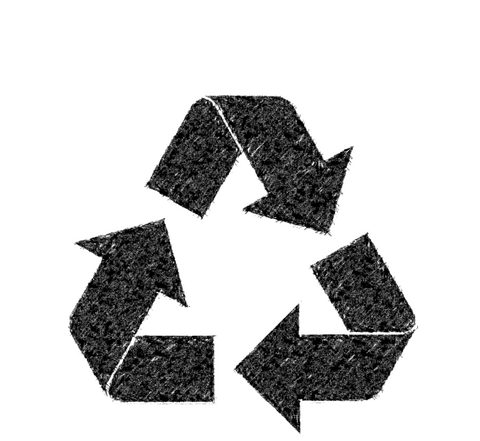Our choice of packaging.
This is probably the topic that took us the most energy when we started: finding the right packaging for our coffees. Of course, like any new brand, we wanted a beautiful setting to highlight the high quality of the beans, while also taking strong environmental considerations into account. Indeed, one of the essential conditions for choosing our packaging was its recyclability.

And, believe us, it's not so simple for coffee, because you need a bag that offers an excellent barrier to oxygen, light, and moisture while also respecting the recycling requirements of the country in which it's sold. We'll tell you about our journey with this packaging choice:
Material - nm
Plant-based plastic : We've looked at the various material options put forward by packaging manufacturers. Plant-based plastic is often mentioned, mostly PLA (polylactic acid). This comes from sugar cane, corn starch, or algae, and is often known as "bio-based plastic" or "bioplastic." Contrary to what one might think, plant-based plastic doesn't guarantee easy recycling; in fact, it could have the opposite effect: in France, we are currently unable to recycle this plastic, and it disrupts recycling. Furthermore, crops dedicated to these plant-based plastics can compete with human food, or even be subject to intensive agriculture, which takes us away from the benefits sought by choosing this alternative. "Bio-based" plastic also doesn't mean it will be biodegradable, quite the contrary.
Biodegradable plastic : certainly one of the biggest disappointments of our research, the promise was nevertheless enticing. When you dig a little deeper, the European standard EN13432, which defines the biodegradability of plastic packaging, stipulates "90% of the dry mass degraded in less than 6 months in an industrial environment," in other words, a full six-month period between 50 and 70 degrees, conditions that are quite rare in the natural environment despite a laudable effort to combat global warming in recent years. Furthermore, even if degradation did occur, the constituents could, according to ANSES (French National Agency for Food, Environmental and Occupational Health and Safety), present potential dangers to human health and the environment. Thus, the national agency recommends "prohibiting any allusion to, or even incitement to, bad habits and establishing a single standard integrating an assessment of biodegradability in all environmental media, with more stringent criteria for their composition."
Compostable plastic : This is an improved version of biodegradable plastic. All compostable plastic is biodegradable; the reverse is not necessarily true. The European standard EN13432 differentiates the concept of compostable by the degradation time under the same conditions: 3 months instead of 6 months to degrade 90% of the dry mass. However, the same issues as with biodegradable plastic still apply, so we decided not to select this packaging.
Recyclable plastic : We had to do some research on the subject, because most coffee bag suppliers are unfamiliar with the recycling structures in France, and may wrongly indicate that a package is recyclable when it will end up incinerated or landfilled. In addition, the sector is evolving quite quickly, as are the instructions. We therefore consulted the recommendations of COTREP (Technical Committee for the Recycling of Plastic Packaging) to gain more clarity. It turns out that in 2022, the date for choosing our packaging, LDPE (or low-density polyethylene) was announced as recyclable, provided it was not mixed with other plastics, paper, or aluminum. We therefore chose this material.
Recycled plastic: frequently encountered among beverage manufacturers (water and sodas) in the form of recycled PET, we personally have not yet found the equivalent for coffee bags, because these are generally made of PE. The advantage of recycled plastic is the fact that it requires little or no virgin plastic (i.e. oil) because it is already at least in its second life, so the carbon impact is reduced. The solution is not perfect either, because the recycling process consumes energy, and the loop is not infinite: a significant portion of the plastic will not be recycled, because of its lower quality and therefore cannot be used again in equivalent packaging.
Printing - nf

To remain recyclable, the ideal is to not print anything on the bag. This is our case today, also for budgetary considerations, but laser printing or non-washable ink would be tolerated. It is possible that we will come to this later. One clarification, however: hot stamping is a widespread process in printing, with a very successful result, but our design agency advised us against it for environmental reasons: the process wastes a significant amount of material and can disrupt the recycling of LDPE in sorting centers.
Dimensions - nf
You may have noticed that our bags are compact and folded on themselves. We have even sometimes received comments about the capacity compared to other bags of the same advertised weight. But we prefer to reassure you: we do put 250 grams in them, no cheating! We selected this format because it allows for good optimization of space in shipping boxes: this means less cardboard is used per box, and we really try to make each shipment "compact".
Valve - nf
As you may know, freshly roasted coffee has an unfortunate tendency to breathe: carbon dioxide escapes, and can cause a coffee bag to swell considerably in the first few days. Nothing serious in principle, unless it opens or explodes if the amount of CO2 accumulated is too high. Therefore, coffee bag suppliers generally offer a one-way valve, which allows this carbon dioxide to escape without letting in oxygen, which would alter the beans.
In our coffee bags, the valve is present, and made of PE, a material tolerated in this case for recycling according to COTREP. However, we are not sure to keep this valve at Celsius. in our next packaging orders, because basically we would just have to let the coffee rest for a few days before systematically putting it in bags to avoid swelling.
Because, even if the bag is still recyclable, the valve adds additional plastic to our bags, and the best waste is the one we don't produce. This solution will be the subject of a study by us in the coming months.
Labels - nf

According to the COTREP website, for our LDPE packaging to always be recyclable, it must not have just any label. Ideally, a label made of the same material can be removed in the wash, but paper labels are also acceptable, provided they are always removable in the wash. This is the solution we chose: two paper labels with adhesive, removable in the wash.
Our current 250-gram packaging consists of a compact bag made of 100% low-density polyethylene without printing but with a polyethylene valve, to which a label and a back label made of paper with non-washable ink are glued. This is the best solution we have found to date, from a "lesser evil" perspective. It is plastic, therefore a petroleum derivative, but there is no better solution to date for our operation.
It seems that the recycled plastic mentioned above is beginning to spread into the coffee bag market, which would constitute a further step in this "lesser evil".
We're closely monitoring developments in France regarding deposits, but it's currently quite difficult for us to consider without a physical point of sale. Bulk is also an ideal solution; some roasters with stores offer it to their customers.
We are always open and interested in discussing these solutions with you, without dogmas or fixed opinions.

